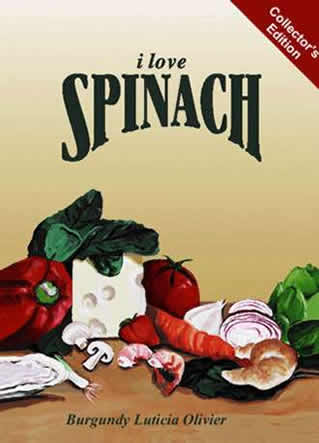|
After washing the leaves, cook them in a covered non-aluminum pan using only the water clinging to the leaves. After cooking, add just a little salt and butter, vinegar, or mustard for added flavor. Fresh tender spinach leaves make excellent salads. Cultural Requirements Spinach is a very hardy crop and can withstand temperatures as low as 20 F. It can be the first garden vegetable planted in the Spring since the seed can germinate at low temperatures. Spinach thrives in cool, moist conditions. It does not tolerate hot weather well and begins to ‘bolt’, or go to seed, as daylight lengthens and temperature increases in June. Fresh spinach seed germinates readily at 38-40F and may be planted with good results when soil temperatures are 50 to 60 F. Higher temperatures will reduce seed germination. Soil temperatures above 85 F will inhibit seed germination. Spinach seed loses viability rapidly and should be purchased fresh each year. Spinach should be planted in rows 12 to 24-inches apart. The seed should be placed 1/2-inch deep and planted to have one plant every 3 to 4 inches after thinning. One packet of seed will plant 25 feet of row. One ounce of seed will plant 100 feet of row. Spinach requires a soil pH of 6.0 - 6.5 and will not grow well if pH is below 6.0. Indications of possible soil pH problems include poor seed germination, yellowing and browning of the margins and tips of seedling leaves, browning of roots, and generally slow growth or death of the plants. If soil pH is too high, leaves may show a generalized yellowing, known as chlorosis. Spinach is adapted to a range of soil types, from light and sandy to silty clay loams. In heavier soils, spinach should be grown on raised beds to improve drainage for the shallow-rooted plants. Seedling damping off can be reduced by using raised beds. After seeding, the soil should be kept uniformly moist. When irrigating the garden, water in the morning so that the foliage is nearly dry before dark. Water sufficiently to moisten the soil to a depth of about six inches. A uniform supply of soil moisture is required to produce high quality, tender spinach. Varieties Spinach varieties are separated into types with flat leaves, leaves that are semi-savoyed (crinkled), or those that are heavily savoyed. The flat-leafed types are used primarily by the processing industry since soil particles are easier to wash off. The thick leaves and ease of washing also make this type attractive to certain fresh market consumers. Whatever type, fresh spinach should be crisp, succulent and dark green, with a minimum of stems. Seven R is a standard, semi-savoyed cultivar that is best for early spring and fall plantings. Plants are large and quick-growing. The erect leaves are good for mechanical harvesting. It is resistant to both race 1 and race 2 of downy mildew. Marathon has a savoy leaf. It is better than Seven R for spring plantings since it is slower to bolt (form flower stalks) in warm weather. The leaves are large, dark green, semi-erect and long standing. It is used for both fresh market and processing from late winter and spring plantings. Melody F1 is a semi-savoyed type. Plants are large and quick growing with very deep color. Leaves are thick and rounded. It is resistant to downy mildew and cucumber mosaic virus. Vienna F1 has large, savoyed leaves forming an erect plant type. It is best planted in the fall as it tends to bolt in spring plantings. Grandstand has semi-savoy leaves, is long-standing and semi-erect. The leaves are medium large and medium green. It is resistant to downy mildew and mosaic and is used in the spring, primarily for processing. Tyee F1 is becoming a new standard for savoyed spinach. The leaves are dark green with an upright growth habit that produces cleaner leaves. It is a bit slower growing than some other savoy types but stands well in hot weather because it is slow to bolt. It is good for a spring crop. It also is tolerant to downy mildew races 1 and 3. Long Standing Bloomsdale is a heavy-savoy type, adapted for late spring and early summer harvest. Leaves are dark green and medium large. Plants are medium large and erect. It is an older variety. Other Bloomsdale types, such as Long Standing Savoy #653, have been selected for earlier maturity and slow bolting. If growing spinach for shipping, the savoy varieties are best because they pack less closely than the smoother types and retain market quality better. They are slower to wilt or turn yellow after harvest. Smooth-leafed varieties are easier to clean and prepare for canning or freezing. Pests Diseases on spinach tend to be those that develop under cool, moist conditions. One symptom characteristic of downy mildew is light-yellow areas on the leaves. Infected young plants may be pale green, stunted, with leaves heavily savoyed. During periods of high relative humidity or rainfall, sporulation will occur, appearing as a white mass, which eventually turns purple. Most modern varieties however are resistant to downy mildew. White rust is a serious problem in spinach production in the southern Great Plains and Texas. White, blister-like pustules appear, usually only on the lower side of the leaf. Surrounding tissue browns and dies. A few fungicides are available for use in spinach produced on a commercial scale. There are no fungicides registered for use by home gardeners on spinach. Insect pests include the green peach aphid, seed corn maggot, cabbage looper, cucumber beetles and the spinach leaf miner. Aphids can be a major problem because they transmit virus to the spinach and are difficult to control, especially in the savoyed leaves. Spinach is shallow rooted. Cultivation to remove weeds must be shallow to minimize damage to the roots. A few herbicides are available for commercial production. For smaller plantings, hand weeding is recommended. Harvesting and Storage Spinach can be harvested until seedstalk formation. Spinach planted for early harvest is subject to bolting as daylight lengthens in late spring and early summer. Spinach is harvested by cutting the stem below the head or rosette of leaves. The crinkled leaves should be rinsed thoroughly in cold water to remove any grit soil particles. The leaves are then bunched. Remember that Fall spinach is very hardy and not easily damaged by frosts. Harvest dark green, tender leaves that are 3 to 6 inches long. In your home garden, start by picking the outer leaves and then harvest the newer leaves as they reach the desired size. Spinach not needed immediately for eating is best left in the field until severe freezing is forecast. |
||
| HOME |  |
 |

